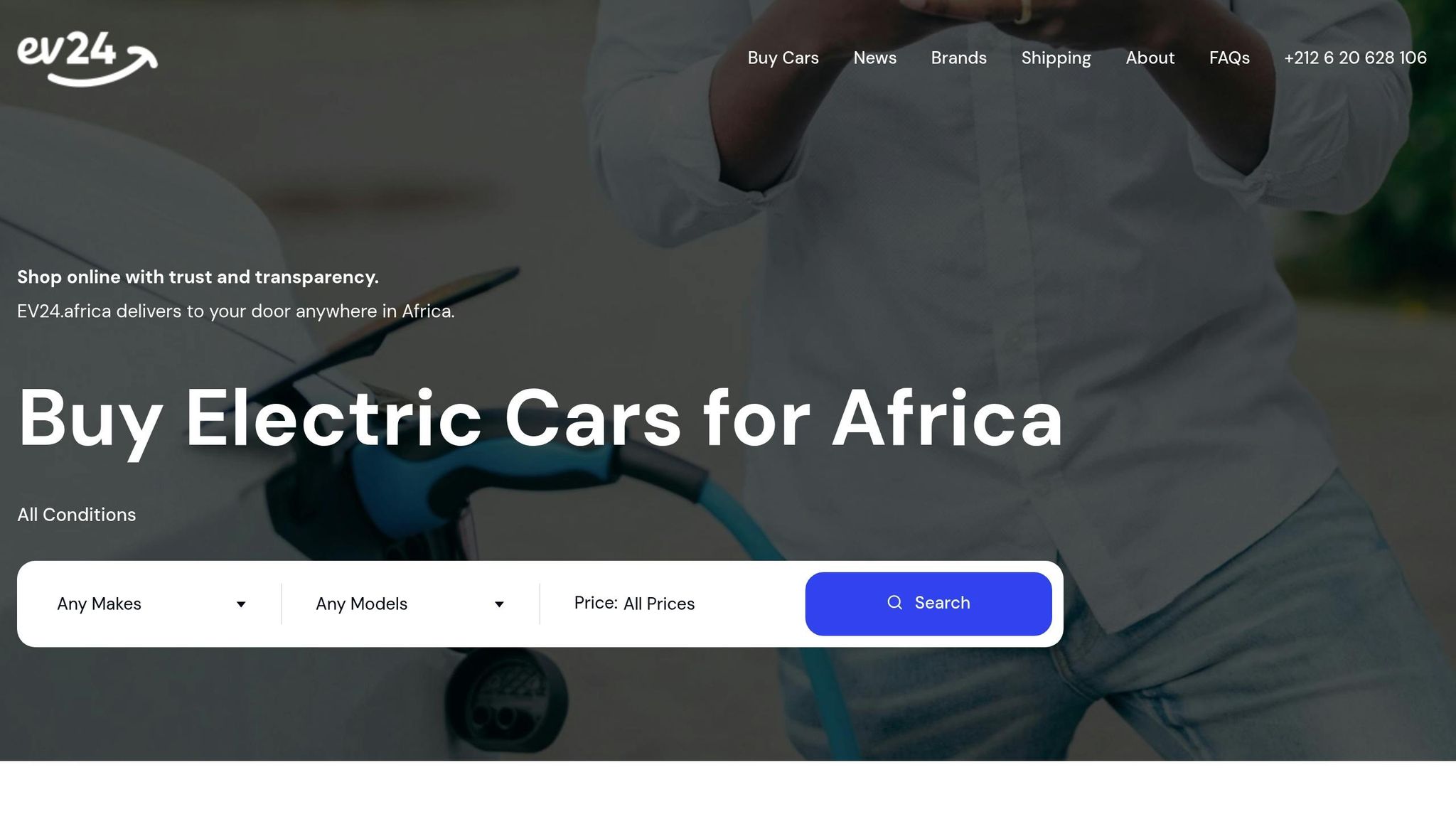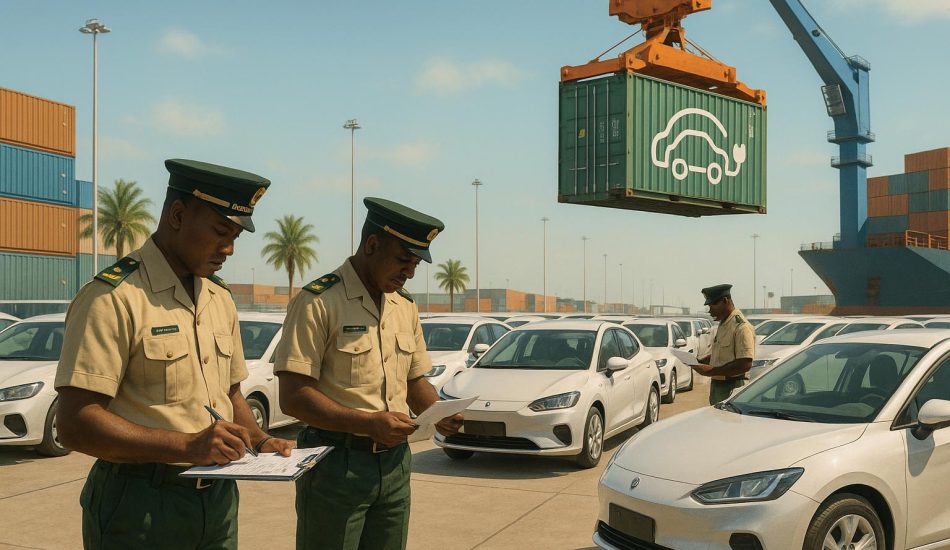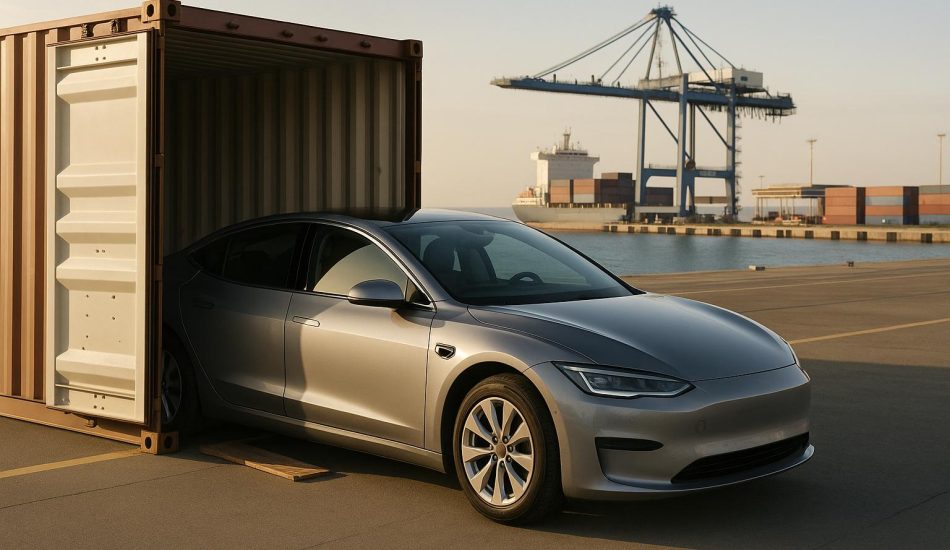
Africa’s electric vehicle (EV) market is growing fast, with its value projected to reach $28.30 billion by 2030 from $17.41 billion in 2025. Here’s what’s driving this growth:
- Government Support: Tax breaks, subsidies, and EV-friendly policies are making EVs more accessible.
- Local Manufacturing: Africa’s rich resources like cobalt and lithium are fueling local EV battery production and assembly.
- Renewable Energy Integration: Solar-powered charging stations and microgrids are addressing energy and infrastructure gaps.
- Consumer Trends: Affordable two- and three-wheelers lead adoption, while urban professionals and businesses are shifting to EVs for cost savings.
Challenges remain, including high upfront costs and limited charging infrastructure. However, collaborations between public and private sectors, innovative charging solutions, and local assembly efforts are paving the way for a stronger EV ecosystem. By 2030, Africa could emerge as a key player in the global EV industry.
Market Size and Growth Projections
Market Value and Growth Rates
The African electric vehicle market is on track for substantial expansion by 2030. Experts estimate its value will hit $15.63 billion in 2024 and climb to around $17.41 billion in 2025, ultimately reaching an impressive $28.30 billion by 2030, with a compound annual growth rate (CAGR) of 10.2%. This rapid growth underscores Africa’s rising prominence in the global electric vehicle industry, fueled by several transformative factors that will be explored further.
Driving The Green Transition with EVs | Future of Sustainability
Key Drivers Shaping Africa’s EV Market
Several factors are propelling the adoption of electric vehicles (EVs) across Africa, setting the stage for notable market growth by 2030.
Government Policies and Incentives
Governments across Africa are rolling out policies aimed at making EVs more accessible and attractive. These initiatives are driven by a desire to cut carbon emissions, reduce reliance on imported fuel, and establish more sustainable transportation systems.
One of the most common strategies is offering tax breaks. Many countries are lowering or even removing import duties on EVs and their components, making them more competitive with traditional gas-powered vehicles. Some nations are also providing direct subsidies for EV purchases or tax credits for businesses investing in electric fleets.
In addition, regulatory changes are paving the way for EV adoption. Emission standards are being tightened to favor cleaner vehicles, and some cities are creating low-emission zones where EVs get priority access. Governments are also introducing streamlined licensing processes for manufacturers and importers. While policies vary from country to country, several nations are leading the way with comprehensive strategies that include infrastructure investments, manufacturing incentives, and consumer-focused programs.
These efforts align with Africa’s natural resource strengths and the growing potential for local manufacturing.
Mineral Resources and Local Manufacturing
Africa is home to abundant reserves of key materials like cobalt, lithium, graphite, and rare earth elements – resources critical for EV battery production.
This mineral wealth is attracting global interest, with international battery makers and automakers setting up operations across the continent. Instead of simply exporting raw materials, many African nations are investing in local processing facilities. This shift not only lowers production costs but also creates jobs and builds expertise in EV technologies.
Collaborations between local businesses and global automakers are also on the rise. These partnerships combine international technical expertise with local knowledge and access to resources. Technology transfer agreements are helping to build local engineering capabilities, while localized supply chains make EVs more affordable and less vulnerable to global disruptions.
These developments in manufacturing and resource utilization are setting the stage for even greater technological advancements.
Advances in EV Technology
Technological progress is making EVs more practical and affordable for African markets. Batteries now last longer, charge faster, and can handle the region’s high temperatures more effectively.
Lower battery costs are driving down the overall price of EVs, while vehicle designs are being tailored to meet local needs. For instance, some models feature higher ground clearance for rough roads, improved dust protection for harsh environments, and even solar charging options to take advantage of Africa’s abundant sunlight. Extended-range models are also being developed to address the limited availability of charging infrastructure in some areas.
Charging technology is evolving as well. Mobile charging units are providing solutions for remote locations, while solar-powered stations offer off-grid options. Fast-charging systems are cutting down wait times, making EVs more convenient for everyday use. On top of that, smart vehicle systems are adding value by helping drivers plan routes, locate charging stations, and monitor vehicle performance, ultimately improving efficiency and cutting operational costs.
Infrastructure Development and Challenges
The growth of Africa’s EV market depends heavily on the development of a reliable charging network. However, there are still major infrastructure challenges that need to be addressed to make widespread adoption possible by 2030.
EV Charging Network Growth
Across Africa, charging infrastructure is gradually expanding as both public and private sectors invest in solutions to meet growing demand. Here are some examples of how innovation is driving progress under challenging conditions:
In December 2024, Zero Carbon Charge introduced CHARGE Wolmaransstad, an off-grid charging station in South Africa powered entirely by solar and battery systems. This station offers ultra-fast charging and operates independently of the country’s often unreliable national grid. The company has ambitious plans to roll out 120 similar stations across the nation. To further this mission, Zero Carbon Charge secured a R100 million investment (about $5.6 million) from the Development Bank of Southern Africa in May 2025 to support the development of climate-resilient infrastructure.
Meanwhile, CHAJI is revolutionizing charging accessibility with its eSOKK – IoT Smart Charging Socket. This 3kW system allows businesses to set up and manage charging stations efficiently. It features wireless connectivity options (2G/3G/4G, Wi-Fi, Bluetooth), authentication via RFID and QR codes, and cloud-based remote monitoring for pricing and data analytics.
Barriers to Infrastructure Expansion
One of the biggest challenges in building EV charging networks across Africa is the instability of power grids. Frequent outages, voltage inconsistencies, and load shedding – problems that plague many regions reliant on national grids – make it difficult to maintain reliable grid-connected charging stations.
Planned Projects and Solutions
To overcome these challenges, innovative approaches are being implemented. Battery swapping, pioneered by Fika Clean Mobility, is one such solution. This method allows EV users to quickly replace depleted batteries with fully charged ones, significantly reducing refueling times and lessening the need for extensive charging infrastructure.
Another promising approach is the deployment of off-grid solar-powered charging stations. These systems generate electricity directly at the charging location, reducing dependence on unreliable national grids and offering more stable energy costs. Additionally, decentralized energy models, which produce power at the point of consumption, are being explored to create a more resilient and consistent energy supply for electric vehicles.
Collaboration between public and private sectors is also playing a key role. Partnerships involving development banks, international donors, and private companies are funding large-scale infrastructure projects. While these projects may not yield immediate profits, they are critical for building the foundation needed to support long-term growth in the EV market.
sbb-itb-99e19e3
Consumer Adoption Patterns and Market Segmentation
Consumer behavior and preferences are shaping the electric vehicle (EV) market as it evolves through 2030. Regional differences in economic conditions and urbanization are key factors influencing adoption trends.
Demographic and Economic Influences
Urban professionals and middle-class buyers are leading the charge as early adopters of EVs. These groups often reside in larger cities where charging infrastructure is slowly taking shape, and policies supporting EV adoption are beginning to emerge. With higher disposable incomes, these consumers are more inclined to look past the higher upfront costs of EVs, focusing instead on long-term savings and environmental benefits.
Younger, tech-savvy individuals are also playing a pivotal role in early adoption. Their enthusiasm for modern technology aligns well with the appeal of EVs. While high initial prices remain a hurdle, innovative financing solutions are helping to make EVs more accessible by lowering upfront costs.
Beyond individual consumers, delivery services, ride-hailing companies, and logistics businesses are increasingly adopting EVs for their lower maintenance and fuel expenses. This shift highlights the growing appeal of EVs in commercial contexts.
These diverse consumer groups are driving preferences for specific types of vehicles, creating a segmented market with distinct priorities.
Market Segmentation by Vehicle Type
The varied consumer base is reflected in the segmentation of Africa’s EV market, with clear preferences emerging across different vehicle categories:
- Two-wheelers and three-wheelers: These vehicles dominate adoption due to their affordability and lower energy requirements. Electric motorcycles, in particular, are gaining traction for commercial uses like taxi services, offering cost-effective mobility solutions.
- Passenger cars: While still considered a premium option, interest in battery electric passenger cars is steadily growing in regions with better charging infrastructure and supportive policies. This segment is gradually shifting toward fully electric models.
- Commercial vehicles: Urban delivery fleets and public transportation are showing strong potential for EV adoption. Pilot programs for electric buses and increased focus on light commercial vehicles highlight the cost benefits of high-mileage, low-maintenance solutions.
- Plug-in hybrid vehicles (PHEVs): In areas where charging infrastructure is limited, PHEVs provide a practical middle ground between electric and conventional power. However, as charging networks expand, battery electric vehicles (BEVs) are becoming more attractive due to their lower operational costs.
Affordability remains a critical factor, with demand focusing on models that balance purchase price with long-term savings. This has spurred interest in competitively priced new vehicles, as well as the import or local assembly of more budget-friendly options.
These trends not only reflect the challenges of limited infrastructure and the ongoing development of EV technology but also underscore the unique trajectory of Africa’s EV market. The focus is on practical, cost-effective mobility solutions tailored to the continent’s economic realities and infrastructural limitations.
Leading Industry Players and Online Marketplaces
Africa’s electric vehicle (EV) market is steadily gaining momentum, with global automakers and platforms like EV24.africa making EV ownership more accessible than ever.
Global and Local Automakers
Global automakers are introducing a wide range of EVs to African buyers. High-end brands like Tesla and Mercedes-Benz cater to those seeking luxury, while manufacturers such as BYD, Volkswagen, XPeng, Leapmotor, and Changan offer more affordable options. On EV24.africa, you can find everything from the budget-friendly GEELY PANDA MINI BASE, priced at $5,880, to the high-end ZEEKR 009, which costs $85,000. This mix of luxury and affordability is helping to shape a diverse and inclusive EV market, with EV24.africa playing a key role in driving this growth.
Role of EV24.africa in Market Growth

EV24.africa stands out as Africa’s first online marketplace dedicated exclusively to EVs. The platform simplifies the process of importing and purchasing electric vehicles by offering transparent pricing that details the total cost of ownership. Operating across all 54 African countries, it provides delivery and support services, making EVs accessible to a broader audience. To further ease adoption, EV24.africa offers flexible payment plans and financing options, breaking down traditional barriers to EV ownership. By aligning with regional policies and supporting local manufacturing efforts, the platform is helping to lay the foundation for a thriving EV ecosystem in Africa.
Value-Added Services Supporting Adoption
EV24.africa goes beyond just selling vehicles by offering a range of services that make EV ownership hassle-free. These include:
- Shipping solutions: Options for RoRo (Roll-on/Roll-off) and container shipping, available for both port-to-port and door-to-door delivery.
- Customs and registration support: Assistance with customs clearance and local vehicle registration.
- Expert advice: Consultations via WhatsApp, complemented by customer reviews that provide practical insights from real users.
Conclusion: Opportunities and Challenges by 2030
Africa’s electric vehicle (EV) market is at a crossroads as it heads toward 2030, offering immense potential for growth if key opportunities are approached strategically.
One of the continent’s biggest advantages is its wealth of natural resources. When managed responsibly, these resources could play a critical role in the EV battery supply chain while also boosting local economies. However, turning this potential into reality calls for investments in processing facilities and job creation to ensure these benefits are felt locally.
Government involvement will be a driving force behind market growth. Policies like reducing import duties, offering tax breaks, and funding infrastructure projects could significantly speed up EV adoption across the region.
That said, there are still hurdles to overcome. Many areas, especially outside cities, lack reliable charging networks and consistent power supplies. On top of that, the high upfront costs of EVs remain a major obstacle for many consumers, even as flexible financing options begin to emerge as a solution.
Addressing these issues will require a unified strategy. Targeting specific market segments – like commercial fleets – could serve as a springboard for broader adoption. In the end, Africa’s EV future depends on coordinated efforts to invest in resource processing, implement supportive policies, and build a solid infrastructure foundation. By tackling these challenges head-on, the continent has a real chance to turn obstacles into opportunities for growth and development.
FAQs
What are the main challenges Africa needs to overcome to build a strong EV charging infrastructure by 2030?
Challenges in Developing EV Charging Infrastructure in Africa
Africa is grappling with several hurdles as it works toward establishing a reliable EV charging network by 2030. A key issue is the scarcity of public charging stations, which fuels range anxiety and discourages potential EV buyers. Without enough accessible chargers, the shift to electric vehicles becomes a tough sell for consumers.
On top of that, the steep costs of installing charging stations pose a significant barrier. Setting up a single station can cost hundreds of thousands of dollars, making widespread infrastructure development a daunting financial challenge.
Another major roadblock lies in regulatory uncertainty. Many African nations lack clear policies or frameworks to guide the expansion of EV infrastructure. This lack of direction stifles private investment, as companies are hesitant to commit without government support or incentives. Adding to the complexity, many regions require substantial upgrades to their existing power grids to handle the increased demand for electricity.
Together, these challenges highlight the intricate task of building a dependable charging network – a critical step for advancing electric mobility across the continent.
How will local manufacturing and resource use shape the affordability and availability of EVs in Africa by 2030?
Local manufacturing has the potential to bring down the cost of electric vehicles (EVs) in Africa by eliminating import-related expenses, strengthening local industries, and generating employment opportunities. By producing EVs closer to home, manufacturers can cut production costs, making these vehicles more affordable for consumers across the continent.
Africa’s abundant reserves of essential minerals like cobalt and lithium – key components in EV batteries – offer another advantage. Tapping into these resources can simplify supply chains and reduce the need for expensive imports. On top of that, advancements in battery technology and improvements in infrastructure are set to make EVs even more accessible, tailoring them to the specific needs of African markets and supporting long-term economic growth.
How are government policies and incentives driving the growth of electric vehicles in Africa?
Government policies and incentives are playing a major role in encouraging the use of electric vehicles (EVs) across Africa. Countries like Kenya, Ethiopia, and South Africa are stepping up with initiatives such as tax reductions, import duty waivers, and subsidies aimed at making EVs more affordable for both individuals and businesses.
Governments are also channeling resources into developing essential EV infrastructure, like charging networks, and promoting local manufacturing to strengthen the industry. Take South Africa, for example – significant funding has been allocated to support domestic EV production. This not only cuts costs but also drives innovation. Such measures are paving the way for a more accessible and greener future for electric mobility across the continent.



